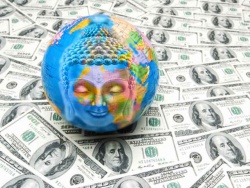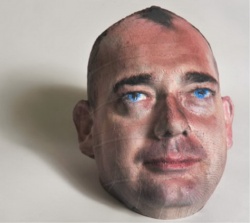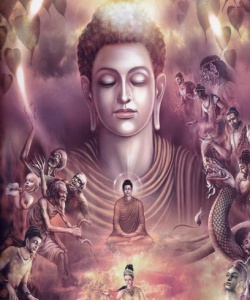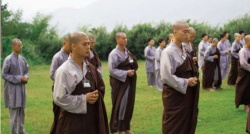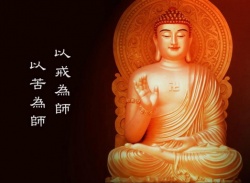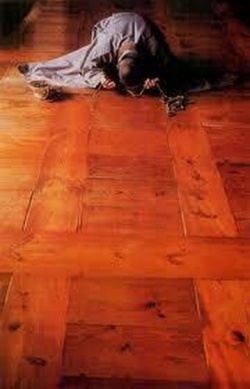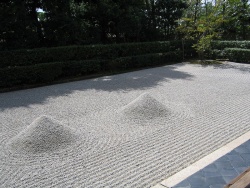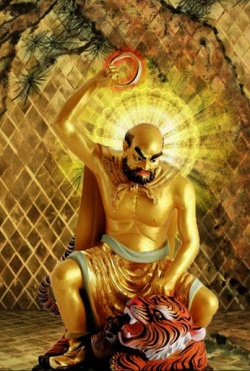Prayer Wheel
A prayer wheel with a wooden handle is leaning upright in this old engraving.
Without the little swinging counter weight, the device is referred to as a prayer mill and works somewhat like a pepper mill.
In places with a Tibetan Buddhist tradition, prayer wheels ( Tib. cho-khor) appear as a series of vertical drums that turn on their axes set in a large installation around the circumference of a stupa or a shrine.
When a practitioner walks around the installation in a clockwise direction and rubs each one with the right hand as he or she passes, they are sent rotating.
In the interiors, thousands of mantras are thought to be activated as the drums on which they are inscribed rotate.
At Land of Medicine Buddha in June 1994, Lama Zopa Rinpoche gave this Advice on the Benefits of Prayer Wheels:
"Just touching and turning a prayer wheel brings incredible purification and accumulates unbelievable merit. "
At Lawudo among the many handwritten texts by Lama Yeshe]] (Kunsang), who had lived in retreat in a cave, was the Mani Kabum with a short explanation of the lineage of the prayer wheel practice and a few lines on how to visualize when doing the practice.
It seems that the Vajrayana practice of the prayer wheel spread when Nagarjuna gave the practice to Lion-faced Dakini, who gave it to Padmasambhava, who then brought it to Tibet.
Lama Zopa mentions that the installation of a prayer wheel seems to have the capacity to completely transform a place and render it " ... peaceful, pleasant, and conducive to the mind."
"One of the benefits of the prayer wheel is that it embodies all the actions of the Buddhas and Bodhisattvas of the 10 directions.
To benefit sentient beings, the Buddhas and Bodhisattvas manifest in the prayer wheel to purify all our negative karmas and obscurations, and to cause us to actualize the realizations of the path to enlightenment.
All the beings (not only the people but also the insects), in the area where the prayer wheel is built are saved from rebirth in the lower realms; they receive a deva or human body, or are born in a pure land of Buddha.
If you have a ... prayer wheel in your house, your house is the same as the Potala, the pure land of the Compassion Buddha.
If you have a prayer wheel next to you when you die, you don't need powa. ... itself becomes a method to transfer your consciousness to a Pure Land.
Simply thinking of a prayer wheel helps a dying person to shoot the consciousness up the central channel and out through the crown to reincarnate in the pure land of Amitabha or the Compassion Buddha.
Simply touching a prayer wheel brings great purification of negative karmas and obscurations. "
Turning a prayer wheel containing 100 million mantras is believed to accumulate the same merit as having recited aloud, 100 million OM MANI PADME HUNGs.
"Turning the prayer wheel once is the same as having done many years of retreat. This is explained as one of the benefits of prayer wheels. "
There are earth, water, fire and wind prayer wheels.
"With the water prayer wheel, the water that touches the wheel becomes blessed. When that water goes into an ocean or lake, it carries the power to purify all the billions of animals and insects there.
A fire prayer wheel is turned by the heat of either a candle or an electric light.
The light that comes from the prayer wheel then purifies the negative karmas of the living beings it touches.
It is similar with a prayer wheel turned by wind.
The wind that touches the prayer wheel is blessed by the power of the prayer wheel and then has the power to purify the negative karmas and obscurations of any being it touches."
"Because prayer wheels are so powerful in purifying negative karmas, I think it is a very good idea to use them. "
" ... prayer wheels stop harm from spirits and other beings, and also stop disease, so one idea I have is to use them for healing. "
For this purpose, "There are two visualizations. With the first, you visualize light beams coming from the mantras in the prayer wheel, illuminating you and purifying you of all your disease and the causes of disease, your negative thoughts and the imprints of these left on your mental continuum.
You then visualize the light illuminating all sentient beings and purifying all their sufferings, as well as their negative karmas and obscurations.
With the second visualization, beams are emitted from the mantras and, like a vacuum sucking up dust, they hook all the disease and spirit harms and, most importantly, the cause of disease, the negative karmas and obscurations.
All these are absorbed or sucked into the prayer wheel.
While reciting five or 10 malas of the mantra, you visualize purifying yourself in this way. "
"At the end, recite some malas while visualizing that the beams emitted from the prayer wheel purify all the sufferings and obscurations of the sentient beings of the six realms. These absorb into the prayer wheel and all sentient beings, including you, are then liberated, actualizing the whole path and becoming the Compassion Buddha."
Lama Zopa says that one can also do circumambulations while doing these visualizations.
He says that " ... . Even though the person might not know about Dharma, about reincarnation or karma, because they want to have peace of mind now and a peaceful death; because they care about having a healthy body and a healthy mind, they should use this extremely powerful and meaningful method of healing. I would like to emphasize that every large and small prayer wheel can be used by sick people for healing." ~ Wisdom Publications, Boston, MA, USA.
As these extracts do not give the full flavour of Lama Zopa's view and personal experience, visit the Medicine Buddhas' site for observations on reincarnating bookworms and more!
"A prayer wheel is a permanent fixture in HE Garchen Rinpoche's hand.
Whenever I think of him holding it, it brings warmth to my heart and sometimes even tears to my eyes. I'm not sure if that's just the "magic" of the wheel, or simply the recollection that he holds the wheel because he is so fully committed to the welfare of us all." ~ S. at the kagyu email list
Ari Salomon's art installation with the prayer wheel as inspiration.
Put a prayer wheel in your computer.
Read about Mantras.
Richard Scheinin wrote for the San Jose Mercury News of Sat., May 5, 2001 that:
Three Tibetan Buddhist monks from Kathmandu were building a prayer wheel in the Santa Cruz Mountains this week. Engraved with mantras, the great wheel, nine feet high, will soon hum softly as it spins, spreading the blessings of compassion across the hills.
So say the monks, who expect the wheel to start spinning by May 16 when the Dalai Lama arrives in the Bay Area to teach and talk to thousands of people. He is the embodiment of all the world's compassion, Tibetan tradition teaches. Not only that, his visit to the area was initiated by the monks' teacher, Lama Zopa, co-founder and spiritual director of this place in the (California) hills, called Land of Medicine Buddha.
. . . . . . . . . . . . . . . . . . . . . . . . . . . . . . . . . . . . . . . . . . . . . . . . . . . . . .
Founded in 1984 on 85 acres, Medicine Buddha is one of 130 centers around the world that belong to the Foundation for the Preservation of the Mahayana Tradition. Mahayana is the stream of Buddhism that includes Tibetan practice. ... .
Flynn, raised in Dublin, Ireland, and the Ven. Sarah Thresher, a Tibetan Buddhist nun from England who lives at the center, walked to a memorial shrine to say hello to Thubten Gelek, a Sherpa and master Tibetan artist who was painting scenes from the life of the Buddha in vivid oranges and blues.
The shrine houses a 24-foot golden Buddha statue made of polystyrene.
It depicts the Maitreya Buddha; according to Buddhist texts, the historical Shakyamuni Buddha, who founded the tradition in the sixth century BC is to be followed by many more Buddhas. The Maitreya Buddha of loving kindness is said to be the next in line.
The statue depicting this future Buddha will be disassembled and moved to Shoreline for the Dalai Lama's visit.
A businessman for much of his life, Flynn has a graduate degree in applied theology and a history of organizing large religious conferences.
Twice in the 1980s he organized conferences at the Vatican where Pope John Paul II and Mother Teresa spoke.
The response was huge; thousands came to witness the events. Yet Flynn said the response to the Dalai Lama -- the almost physical need of people to attend, to sit close to the stage to fully experience ``His Holiness -- exceeds what he observed in Rome.
Thresher has studied with the Dalai Lama for 18 years and was ordained by him 15 years ago in Bodh Gaya, India, where the Shakyamuni Buddha received enlightenment. She has also lived at various times in Dharamsala, India, where the Dalai Lama has his home and the Tibetan government-in-exile is headquartered.
"A lot of people would come and shake his hand, she said, "and when they looked into the face of the Dalai Lama, they would start crying. They don't know why, but he has this kind of effect . . . . He has the ability to reflect the kindness in their hearts. They cried with joy.
Over at the prayer wheel, a monk named Nyima Tashi stood on tiptoes, winding rolls of microfilm into the opening at the top of the wheel. Each roll contained 28 million mantras, or prayers. When the wheel is finished, it will hold 3,600 rolls of microfilm, containing more than 100 billion mantras. Then it will turn slowly, spinning many blessings over the Land of Medicine Buddha."
see also: About Prayer Wheels
